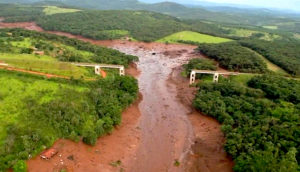By Peter Kennedy

Vale SA, the world’s largest iron ore miner, has vowed to sacrifice production for safety to avoid another tailings dam failure. (Image: Screenshot from BBC News video.)
Analysts have begun to weigh the consequences of a deadly tailings dam breach at a Brazilian mine operated by Vale SA [VALE-NYSE], the world’s largest producer of iron ore and nickel.
The Brumadinho dam breach, which occurred on Friday January 25, 2018, killed at least 65 people. Another 279 have been declared missing according to published reports.
Brazilian police have since arrested five people, including three Vale employees and two subcontracted engineers, according to a report in the Guardian newspaper.
Early Wednesday, Vale announced that it will be curtailing 40 million tons of iron ore concentrate production capacity as it moves to shut down any remaining mines that have similar style tailings dams to the one which failed last week.
Scotiabank estimates that 40 million tonnes represents only 10% of Vale’s total production capacity and is likely to be offset by production at some of its other mines which had latent capacity prior to Friday’s disaster.
Vale has the capacity to produce 450 million tonnes of iron ore.
Not surprisingly, in the past week, the price of iron ore price has jumped to $83 a tonne from $74 a tonne. Meanwhile Vale is taking 11 million tons of pellet capacity offline, an amount that represents 10% of the global seaborne pellet market.
“The most recent pellet price from January was +$60 per tonne, and given this news, there will be upward pressure on this price when we get new data at the beginning of February,” Scotiabank said in a report.
Some analysts are already expecting pellet premiums to test recent highs of $90 per tonne.
The tailings dam breach near Brumadinho has been declared a Brazilian national disaster. Three years ago, a similar disaster occurred in the same state at a mine operated by Samarco, a joint venture involving Vale and BHP Billiton Ltd. [BHP-NYSE; BHPLF-OTCPK]. It resulted in the death of 10 people and poisoned local drinking water.
Fitch and Moody’s have downgraded their credit ratings on Vale “on the expectation that the company will incur heavy repatriation costs as a result of the accident and the expectation of decreased production in the near-to-intermediate term and additional capex for remediation and other expenditures needed to ensure safety.
Scotiabank has hinted at a possible impact on the price of nickel. It said the current disaster – while it hasn’t occurred at any large nickel operations – poses a risk to future supply given the relative severity of the disaster and the fact that this is the second one in three years.
Vale has substantial nickel mining operations in Canada (including Sudbury, Ontario, and Voisey’s Bay, Labrador) as well as in Caledonia and Indonesia.
Nickel supply could be curtailed because of the potential associated wide-ranging implications at company and global mining level.
Meanwhile, since news of the latest disaster broke, Vale shares have tumbled from US$15.41 on January 25, 2019 to as low as low as US$11.55 on January 29, 2019. On Wednesday, the shares continued to claw back some lost ground, rising 8% or US$0.92 to US$12.40.
Vale said this week it has presented to Brazilian authorities a plan to decommission all of its dams built by the upstream method. “The plan presented to the Brazilian authorities aims to de-characterize these structures as tailings dams in order to reintegrate them into the environment, the company said.
Vale said it currently has 10 dams built by the upstream method. All of them are currently inactive.
The company has estimated that it will cost around US$2.5 billion to decommission its upstream dams, a process that is expected to occur over the next three years.
In order to carry out the decommissioning of the upstream dams safely and quickly, Vale said it will temporarily halt the production of units where the structures are located. It said the estimated impact of the production stoppage is about 40 million tons of iron ore per year. Included in this figure is the pellet feed needed for the production of 11 million tons of pellets.
However, it said some of that impact is expected to be offset by the increase in production at other company operations.
